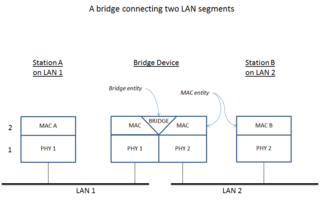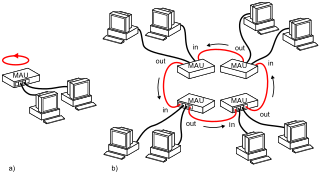
A frame check sequence (FCS) is an error-detecting code added to a frame in a communication protocol. Frames are used to send payload data from a source to a destination.

A frame check sequence (FCS) is an error-detecting code added to a frame in a communication protocol. Frames are used to send payload data from a source to a destination.
All frames and the bits, bytes, and fields contained within them, are susceptible to errors from a variety of sources. The FCS field contains a number that is calculated by the source node based on the data in the frame. This number is added to the end of a frame that is sent. When the destination node receives the frame the FCS number is recalculated and compared with the FCS number included in the frame. If the two numbers are different, an error is assumed and the frame is discarded.
The FCS provides error detection only. Error recovery must be performed through separate means. Ethernet, for example, specifies that a damaged frame should be discarded and does not specify any action to cause the frame to be retransmitted. Other protocols, notably the Transmission Control Protocol (TCP), can notice the data loss and initiate retransmission and error recovery. [2]

The FCS is often transmitted in such a way that the receiver can compute a running sum over the entire frame, together with the trailing FCS, expecting to see a fixed result (such as zero) when it is correct. For Ethernet and other IEEE 802 protocols, the standard states that data is sent least significant bit first, while the FCS is sent most significant bit (bit 31) first. An alternative approach is to generate the bit reversal of the FCS so that the reversed FCS can be also sent least significant bit (bit 0) first. Refer to Ethernet frame § Frame check sequence for more information.
By far the most popular FCS algorithm is a cyclic redundancy check (CRC), used in Ethernet and other IEEE 802 protocols with 32 bits, in X.25 with 16 or 32 bits, in HDLC with 16 or 32 bits, in Frame Relay with 16 bits, [3] in Point-to-Point Protocol (PPP) with 16 or 32 bits, and in other data link layer protocols.
Protocols of the Internet protocol suite tend to use checksums. [4]

Ethernet is a family of wired computer networking technologies commonly used in local area networks (LAN), metropolitan area networks (MAN) and wide area networks (WAN). It was commercially introduced in 1980 and first standardized in 1983 as IEEE 802.3. Ethernet has since been refined to support higher bit rates, a greater number of nodes, and longer link distances, but retains much backward compatibility. Over time, Ethernet has largely replaced competing wired LAN technologies such as Token Ring, FDDI and ARCNET.
Internetwork Packet Exchange (IPX) is the network layer protocol in the IPX/SPX protocol suite. IPX is derived from Xerox Network Systems' IDP. It also has the ability to act as a transport layer protocol.
IEEE 802.2 is the original name of the ISO/IEC 8802-2 standard which defines logical link control (LLC) as the upper portion of the data link layer of the OSI Model. The original standard developed by the Institute of Electrical and Electronics Engineers (IEEE) in collaboration with the American National Standards Institute (ANSI) was adopted by the International Organization for Standardization (ISO) in 1998, but it remains an integral part of the family of IEEE 802 standards for local and metropolitan networks.
In computer networking, the maximum transmission unit (MTU) is the size of the largest protocol data unit (PDU) that can be communicated in a single network layer transaction. The MTU relates to, but is not identical to the maximum frame size that can be transported on the data link layer, e.g., Ethernet frame.
In computer networking, Point-to-Point Protocol (PPP) is a data link layer communication protocol between two routers directly without any host or any other networking in between. It can provide loop detection authentication, transmission encryption, and data compression.

Frame Relay is a standardized wide area network (WAN) technology that specifies the physical and data link layers of digital telecommunications channels using a packet switching methodology. Originally designed for transport across Integrated Services Digital Network (ISDN) infrastructure, it may be used today in the context of many other network interfaces.
Carrier-sense multiple access with collision detection (CSMA/CD) is a medium access control (MAC) method used most notably in early Ethernet technology for local area networking. It uses carrier-sensing to defer transmissions until no other stations are transmitting. This is used in combination with collision detection in which a transmitting station detects collisions by sensing transmissions from other stations while it is transmitting a frame. When this collision condition is detected, the station stops transmitting that frame, transmits a jam signal, and then waits for a random time interval before trying to resend the frame.
In the IEEE 802 reference model of computer networking, the logical link control (LLC) data communication protocol layer is the upper sublayer of the data link layer of the seven-layer OSI model. The LLC sublayer acts as an interface between the media access control (MAC) sublayer and the network layer.
The data link layer, or layer 2, is the second layer of the seven-layer OSI model of computer networking. This layer is the protocol layer that transfers data between nodes on a network segment across the physical layer. The data link layer provides the functional and procedural means to transfer data between network entities and may also provide the means to detect and possibly correct errors that can occur in the physical layer.

In IEEE 802 LAN/MAN standards, the medium access control (MAC), also called media access control, is the layer that controls the hardware responsible for interaction with the wired or wireless transmission medium. The MAC sublayer and the logical link control (LLC) sublayer together make up the data link layer. The LLC provides flow control and multiplexing for the logical link, while the MAC provides flow control and multiplexing for the transmission medium.
IEEE 802.1Q, often referred to as Dot1q, is the networking standard that supports virtual local area networking (VLANs) on an IEEE 802.3 Ethernet network. The standard defines a system of VLAN tagging for Ethernet frames and the accompanying procedures to be used by bridges and switches in handling such frames. The standard also contains provisions for a quality-of-service prioritization scheme commonly known as IEEE 802.1p and defines the Generic Attribute Registration Protocol.

Ethernet flow control is a mechanism for temporarily stopping the transmission of data on Ethernet family computer networks. The goal of this mechanism is to avoid packet loss in the presence of network congestion.

A network bridge is a computer networking device that creates a single, aggregate network from multiple communication networks or network segments. This function is called network bridging. Bridging is distinct from routing. Routing allows multiple networks to communicate independently and yet remain separate, whereas bridging connects two separate networks as if they were a single network. In the OSI model, bridging is performed in the data link layer. If one or more segments of the bridged network are wireless, the device is known as a wireless bridge.
In computer networking, jumbo frames are Ethernet frames with more than 1500 bytes of payload, the limit set by the IEEE 802.3 standard. The payload limit for jumbo frames is variable: while 9000 bytes is the most commonly used limit, smaller and larger limits exist. Many Gigabit Ethernet switches and Gigabit Ethernet network interface controllers and some Fast Ethernet switches and Fast Ethernet network interface cards can support jumbo frames.

Token Ring is a computer networking technology used to build local area networks. It was introduced by IBM in 1984, and standardized in 1989 as IEEE 802.5. It uses a special three-byte frame called a token that is passed around a logical ring of workstations or servers. This token passing is a channel access method providing fair access for all stations, and eliminating the collisions of contention-based access methods.
In computer networking, an Ethernet frame is a data link layer protocol data unit and uses the underlying Ethernet physical layer transport mechanisms. In other words, a data unit on an Ethernet link transports an Ethernet frame as its payload.
Frame aggregation is a feature that allows communicating on a shared link or channel, typically a TDM shared channel, with a minimum time slot that for efficiency reasons benefits from filling the time slot with data, i.e. sending two or more data frames in a single transmission. The feature is an important part of the IEEE 802.11e, 802.11n and 802.11ac wireless LAN standards that increases throughput with frame aggregation. The MoCA protocol used for communication over coaxial networks also implements frame aggregation for the same reason. In protocol standards and implementations, the frame aggregation is usually combined with segmentation and reassembly of frames so that the time slots can be filled to 100%. E.g., an aggregation MAC PDU can be filled with 3.5 frames to ensure the time slot is utilized to 100% and in the next time slot the rest of the fragmented frame is sent together with any additional complete frames.
TRILL is an Internet Standard implemented by devices called TRILL switches. TRILL combines techniques from bridging and routing, and is the application of link-state routing to the VLAN-aware customer-bridging problem. Routing bridges (RBridges) are compatible with and can incrementally replace previous IEEE 802.1 customer bridges. TRILL Switches are also compatible with IPv4 and IPv6, routers and end systems. They are invisible to current IP routers, and like conventional routers, RBridges terminate the broadcast, unknown-unicast and multicast traffic of DIX Ethernet and the frames of IEEE 802.2 LLC including the bridge protocol data units of the Spanning Tree Protocol.
Parallel Redundancy Protocol (PRP) is a network protocol standard for Ethernet that provides seamless failover against failure of any network component. This redundancy is invisible to the application.
Time-Sensitive Networking (TSN) is a set of standards under development by the Time-Sensitive Networking task group of the IEEE 802.1 working group. The TSN task group was formed in November 2012 by renaming the existing Audio Video Bridging Task Group and continuing its work. The name changed as a result of the extension of the working area of the standardization group. The standards define mechanisms for the time-sensitive transmission of data over deterministic Ethernet networks.